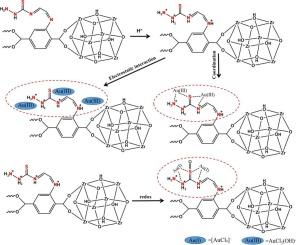硫脲改性Zr-MOF从酸性废水中高效回收(Au)(III)
IF 6.7
2区 工程技术
Q1 ENGINEERING, CHEMICAL
引用次数: 0
摘要
新型贵金属回收吸附剂的设计与开发具有显著的社会经济效益;本研究利用富含氨基和巯基的工业常用化学物质硫脲对uio -66- nh2进行改性,成功合成了高性能的金离子吸附剂UiO-66-TMB。所得材料具有良好的稳定性和吸附性能,在pH = 2时,最大吸附量为729.15 mg·g−1。该吸附剂具有良好的可回收性,在含有多种杂质离子的环境中仍能保持优良的选择性。此外,即使在较低初始金离子浓度的强酸性条件下,也能保持705.6 mg·g−1的饱和吸附量。机理研究表明,Au与材料表面含N、S元素的官能团之间存在静电吸引、配位结合、氧化还原反应等协同作用。本研究提出的功能化策略为开发高效稳定的贵金属吸附材料开辟了新的研究方向,为工业废水和电子废弃物的可持续资源回收提供了潜在的解决方案。本文章由计算机程序翻译,如有差异,请以英文原文为准。

Highly efficient (Au)(III) recovery from acid wastewater by thiosemicarbazide modified Zr-MOF
The design and development of new precious metal recovery adsorbents have significant socio-economic benefits; this study successfully synthesized a high-performance gold ion adsorbent, UiO-66-TMB, by modifying UiO-66-NH₂ with thiosemicarbazide, a common industrial chemical rich in amino and thiol groups. The obtained material exhibits excellent stability and adsorption performance, with the maximum adsorption capacity of 729.15 mg·g−1 at pH = 2. The adsorbent has good recyclability and can maintain superior selectivity in environments containing multiple impurity ions. In addition, even under strong acidic conditions with low initial gold ion concentration, a saturated adsorption capacity of 705.6 mg·g−1 can be maintained. Mechanism studies have shown that there is a synergistic effect between electrostatic attraction, coordination binding, and redox reactions between Au and functional groups containing N and S elements on the surface of materials. The functionalization strategy proposed in this work opens new research directions for developing efficient and stable precious metal adsorption materials, offering a potential solution for sustainable resource recovery from industrial wastewater and electronic waste.
求助全文
通过发布文献求助,成功后即可免费获取论文全文。
去求助
来源期刊

Journal of water process engineering
Biochemistry, Genetics and Molecular Biology-Biotechnology
CiteScore
10.70
自引率
8.60%
发文量
846
审稿时长
24 days
期刊介绍:
The Journal of Water Process Engineering aims to publish refereed, high-quality research papers with significant novelty and impact in all areas of the engineering of water and wastewater processing . Papers on advanced and novel treatment processes and technologies are particularly welcome. The Journal considers papers in areas such as nanotechnology and biotechnology applications in water, novel oxidation and separation processes, membrane processes (except those for desalination) , catalytic processes for the removal of water contaminants, sustainable processes, water reuse and recycling, water use and wastewater minimization, integrated/hybrid technology, process modeling of water treatment and novel treatment processes. Submissions on the subject of adsorbents, including standard measurements of adsorption kinetics and equilibrium will only be considered if there is a genuine case for novelty and contribution, for example highly novel, sustainable adsorbents and their use: papers on activated carbon-type materials derived from natural matter, or surfactant-modified clays and related minerals, would not fulfil this criterion. The Journal particularly welcomes contributions involving environmentally, economically and socially sustainable technology for water treatment, including those which are energy-efficient, with minimal or no chemical consumption, and capable of water recycling and reuse that minimizes the direct disposal of wastewater to the aquatic environment. Papers that describe novel ideas for solving issues related to water quality and availability are also welcome, as are those that show the transfer of techniques from other disciplines. The Journal will consider papers dealing with processes for various water matrices including drinking water (except desalination), domestic, urban and industrial wastewaters, in addition to their residues. It is expected that the journal will be of particular relevance to chemical and process engineers working in the field. The Journal welcomes Full Text papers, Short Communications, State-of-the-Art Reviews and Letters to Editors and Case Studies
 求助内容:
求助内容: 应助结果提醒方式:
应助结果提醒方式:


